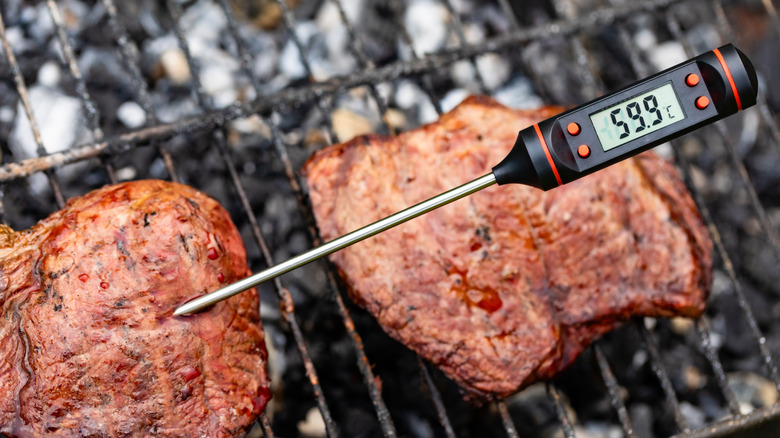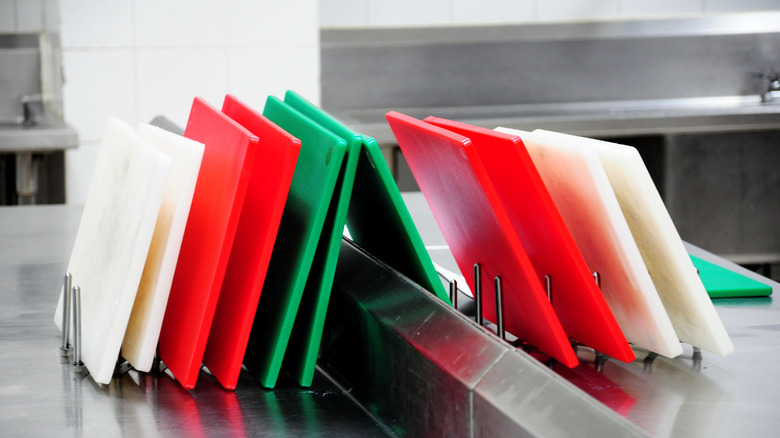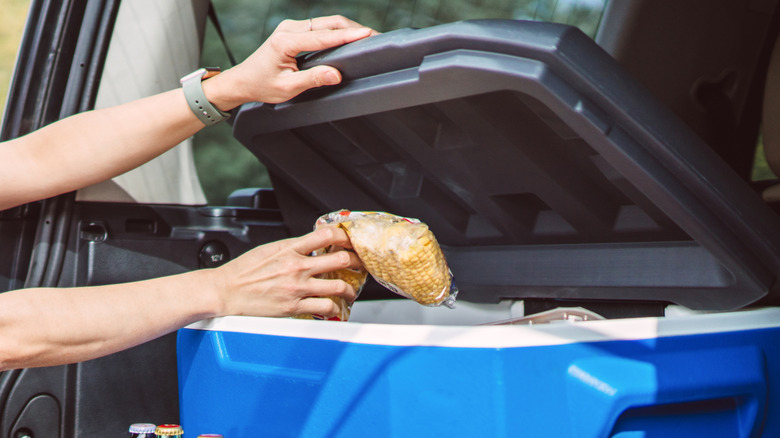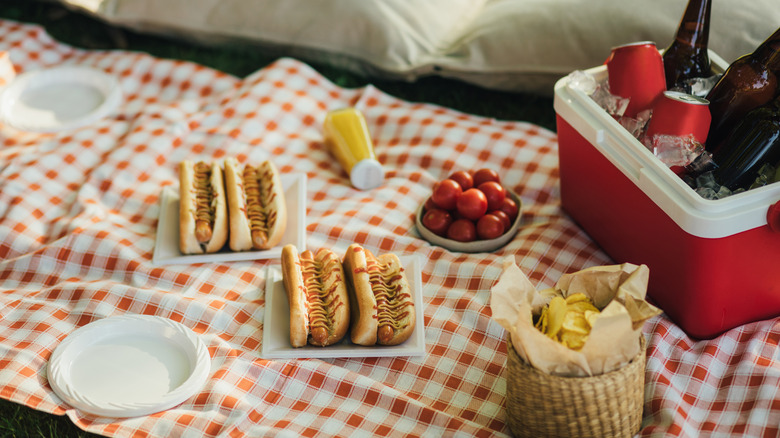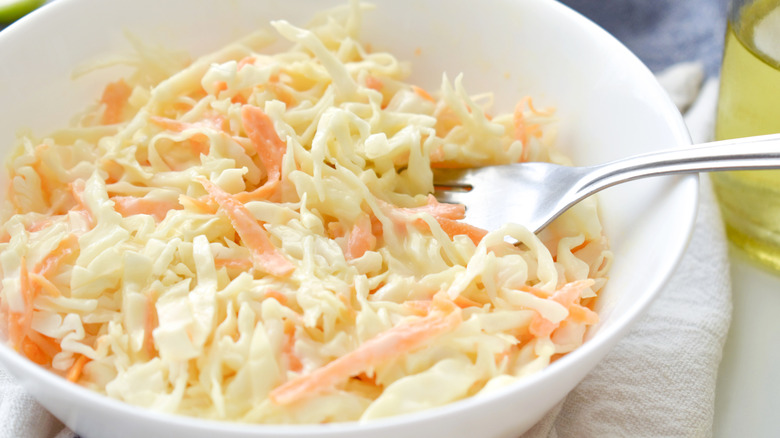5 Important Food Safety Tips For Your Next Picnic
As the seasons turn and spring starts to roll in, the return of picnics becomes inevitable. After a long, cold winter, there's really nothing like eating (or cooking, for that matter) in the open air. Picture it: a nice warm evening, a cold beer in hand, and ... food poisoning? Hang on, that's not part of the plan! In fact, as anyone who has ever had it can attest, it's uniquely nasty. Unfortunately, though, as the weather gets warmer it becomes the reality for many an unprepared (and uninformed) picnicker. Luckily, though, we're here to guide you on how to pack the perfect picnic and, with just a few easy tricks, you can ensure your food stays fresher, for longer.
For the chefs among you, this stuff will be common knowledge — but for the average home cook, there's an awful lot you might not know about food hygiene that's crucial to making sure your food is safe, not just tasty. Having a basic knowledge of how to keep your food cool, for example, or how to properly package it to avoid contamination, could be the difference between picnic perfection and al fresco failure. So, the next time you're packing the ultimate picnic hamper, keep these tips in mind. They might just save your bacon and, more importantly, your stomach.
Maintain safe food temperatures at all times
One of the most useful tools in any cook's arsenal is the instant read thermometer. These are great for knowing exactly what temperature a piece of meat, or fish is. Not only are they a must for a foolproof steak, but they're also a crucial tool in professional kitchens to let chefs know if food is safe to eat. Temperature isn't just important — it's everything. Between 40 and 140 degrees Fahrenheit is known as the "danger zone." It's here that bacteria are most prone to multiplying. When it comes to packing a picnic, that means keeping the hot foods hot, and the cold foods cold.
For those aforementioned cold foods, things like deli meats, salads and dairy products like fresh cheese, you'll want to keep things at a chilly 40 degrees Fahrenheit (that's four degrees Celsius) or below. Insulated coolers are your best bet here and pairing them with ice packs is the best way to ensure all your cold food stays fresh and safe to eat. Similarly, you'll want to use insulated containers like thermos flasks — or Stanley cups (which, surprisingly, make for a great way to store your hot dogs) — to keep the hot stuff hot, preferably above 140 degrees Fahrenheit until you serve it. If you don't have anything to keep your food insulated, don't worry. Just make sure to eat your food faster! As long as you avoid leaving your food out for more than a couple hours (or an hour if it's a super-hot day) you're all good to go.
Preventing cross contamination is an essential food safety step
If you're not a chef, but you know anything about restaurants, you might be familiar with the color-coded system of chopping boards commonly used in professional kitchens. For example, red is for raw meat, blue for fish, yellow for poultry, and so on and so forth. It's an essential tool to avoid cross contamination, which entails separating certain types of food for safety's sake. While you don't need to implement a professional-level system of color coding in your own kitchen, you should take good care to avoid any cross contamination at home and at your next picnic.
This starts when you're making your picnic food. If you can use different cutting boards for raw and cooked foods, do it. If you don't, though, just make sure that you thoroughly clean your boards before and after prepping any meat or fish you might be bringing with you. If you're grilling on the go, for example, it's important that you keep any ready-to-eat items like cold meats or salads away from raw food, to reduce the risk of food poisoning. You can do this either by using separate coolers for raw and cooked foods, or simply by packing your foods securely using plastic wrap, zip top bags, or containers like Tupperware boxes. Make sure to wash your hands frequently, too — especially before and after touching raw meat. This will help you avoid contaminating anything you might touch after that won't be cooked, like fresh fruit or salad.
How to properly use your coolers
You might think that using a cooler is pretty self-explanatory. Put your food in, keep it cool, take your food out, and enjoy, right? Well, making proper use of your cooler is a little more complicated than that. Using your cooler correctly starts with packing it efficiently. Make sure you're using a clean cooler (give it a wipe down before you use it to make sure that you don't risk any lingering bacteria contaminating your food) and pre-chill it for an hour before packing it. Using ice packs, or even frozen water bottles, is a good way to effectively cool things down. If you can, make sure that the lid is tight fitting: If it's too loose, then your cooler won't be very effective at keeping anything cold as it'll let all that chilly air out.
Then, once you're ready to pack, start with the items you need to keep cold the most; think raw or cooked meats. Wrap them up tightly and store them at the bottom of the cooler, with plenty of ice packs. This will help avoid cross contamination and keep things super cool. Then, add a layer of other produce like dairy, dips, fruits and salads. Finally, your top layer should consist of the stuff you'll be reaching for most frequently — drinks and snacks, for example. Then, once you get to your picnic spot, try to keep your cooler in the shade, and cover it with a towel or blanket to make sure it stays nice and insulated.
How to serve food to optimise food safety
As you've probably gathered, temperature is key when it comes to maintaining safe food standards, especially when out and about on a hot day. While prepping, cooking and packing your food correctly is a great start, you should probably also think about safety when it comes to actually serving it. We mentioned the "danger zone" earlier — when food is at between 40 and 140 degrees Fahrenheit, bacteria multiply far faster — so it's important to not let big batches of food sit out in the sun for too long. A simple fix that might not have occurred to you is to serve food in smaller batches, instead. Rather than dishing out everything you've made all at once, keep some portions back in the cooler and serve a bit at a time.
This tactic will help stop easily perishable picnic staples (like skewers with meat or fish, for example) sitting out in the heat and going bad. This is especially useful if your picnic is a chilled out, all-day affair where people will be grazing throughout the afternoon. Once the first round of food's been eaten, simply grab a fresh batch from the cooler. Not only will your food be safer, but it'll also stay fresher, making for a tastier picnic that your guests will be sure to thank you for. To make this a more efficient process (and to avoid time spent with the cooler open) be sure to label everything clearly.
Watch out for mayonnaise and dairy-based dishes
Now, we can't deny that dairy is a picnic staple. From coleslaw to potato salad to refreshing, creamy onion dips, dairy is an essential part of packing the perfect picnic. But those delicious dairy products are, unfortunately, especially prone to spoiling when left out for too long, and particularly in the height of summer. According to the USDA (and it's safe to say they know a thing or two about food safety) you shouldn't leave them out for more than an hour when it's over 90 degrees Fahrenheit out. And let's face it — even if they haven't been out for all that long, nobody wants to eat warm sour cream, do they?
Thankfully, this doesn't mean that you need to skip them out entirely; you just need to probably pay them a little more attention. Keep them covered and chilly in your cooler until the moment you want to eat them or consider using an ice bowl to keep them refrigerated once you've served them. For that, fill a larger bowl with ice and place a smaller serving bowl (or bowls) inside it. This'll mean that your dips stay cool and easy to access for any grazing picnic-goers. You could also try swapping out that mayonnaise in your coleslaw or pasta salad for Greek yogurt. It's usually a little more resilient in the heat and has a delicious flavor all of its own that'll bring a little tangy complexity to your picnic classics — plus, it's great for your gut!

